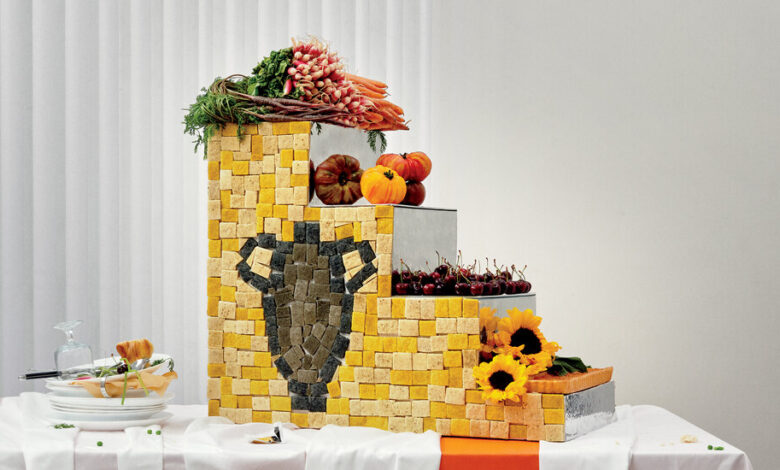And for Our Next Course … the Centerpiece

AT A RECENT event in Paris for the London-based jewelry brand Alighieri, the food artist Imogen Kwok laid out along the length of a lavish banquet table blocks of steamed couscous and bulgur that she crumbled at the corners to evoke ancient ruins. Alighieri, which takes its name from the medieval Florentine poet and philosopher Dante Alighieri, specializes in gold pendants that recall Roman heirlooms, whose sense of antiquity the 31-year-old Kwok wanted to reflect in her tablescape. Trimming the couscous monoliths were oven-blistered cherry tomatoes and pickled cherries, fleshy scallops displayed in their shells like archaeological treasures and cooked green beans plaited into braids.
Instead of being part of a traditional table setting — in which plates and cutlery flank a floral arrangement — the composition functioned as centerpiece and meal (guests were encouraged to serve themselves and dined at a separate table). Kwok was inspired by the French Algerian artist Kader Attia, who in 2009 used couscous, a North African staple, to build a scale model of the ancient city of Ghardaia, Algeria. “I wanted to treat the table as a canvas,” Kwok says. “I like to look at what artists are doing and work out how to make that into something you can smell, taste and eat.”
Her work reflects a recent trend in entertaining that challenges what a table — and the food on it — should look like and do. The new dinner party must not only feature delicious food: It must also now be immersive, and even slightly surreal. Gone, or at least sidelined, are flowers and china; in their place is an upending of the very idea of decoration. “It’s all gotten very theatrical,” says the Paris-based event planner and food curator Alice Moireau, 26, who also has a line of place setting accessories called Table. “It used to be Scandinavian minimalism; now it’s all about abundance.”
There’s something subversive, if not unsettling, in that expectation. Yet treating food as ornamentation has long historical precedent. In ancient Greece, the banquet was a way of impressing others with one’s wealth and status. Our current tastes, however, hew closer to the ideals of the controversial Italian poet and art theorist Filippo Tommaso Marinetti, who founded the Futurist movement in 1909, in part as a reaction against what he saw as outdated modes of expression. As Marinetti explains in his provocative 1932 manifesto “The Futurist Cookbook” — which is more of a treatise on aesthetics than an actual cookbook — food can be a valuable tool for artistic expression. It is not enough, he writes, for a meal to satisfy an appetite; its presentation should delight all five senses. Marinetti calls for, above all else, absolute originality, from “the table setting (crystal, china, décor) extending to the flavors and colors of the foods” to “the invention of appetizing food sculptures, whose original harmony of form and color feeds the eyes and excites the imagination before it tempts the lips.”
TODAY’S VERSIONS OF appetizing food sculptures are made with a wink. Take, for instance, the work of the New York-based artist Laila Gohar, 34, who has decorated tables with trees made from asparagus and langoustines; cakes from sausage links; and butter carvings in the shape of neo-Classical columns, which she often serves with an assortment of breads or hot pink clusters of French breakfast radishes. Or there are the trompe l’oeil arrangements of meringue handbags and charcoal-powder marshmallows in the shape of canelés and madeleines by the 33-year-old Parisian chef Zélikha Dinga, whose interest in making cream-laden cakes and pastries comes from a childhood frustration with not being allowed to eat sugar. “Now, at the end of the meal, I like to have something grand,” she says.
Then there’s the Parisian creative director Clarisse Demory, 47, whose table compositions are distinguished by their sense of spontaneity, recalling the canvases of the Dutch Baroque painter Abraham van Beyeren, in which an errant fruit peel always seems to dangle off a slightly askew tablecloth. “I like when food is photographed in a free and creative way, using a flash, much like you would shoot fashion,” Demory says.
Alix Lacloche, 37, is a French American chef known for her ability to create distinctly conceptual meals. In 2020, after a Jacquemus runway show that took place an hour north of Paris in the rolling wheat fields of Val d’Oise, she draped a large table with white cloth, ruching it in places to imitate the look of unmade sheets, and then tucked grilled almonds, figs and goat cheese wrapped in nasturtium leaves among the folds to suggest an impromptu meal in bed.
Lacloche has a fondness for the “pre-internet innocence” of 1970s crafting and Judy Chicago’s fine art take on it, as well as for the work of the sculptor Alexander Calder, the filmmaker Michel Gondry and the vaudevillians known as the Marx Brothers — playful personalities “who can transform simple things into great things.” Her own food, too, projects a sense of whimsy. For a book event in Athens last May, she paid homage to Greece’s religious icons by wrapping an entire table in foil and covering it with olives, mint leaves and hunks of feta — the result was divine but also quotidian, succor for the body and the soul.
Set design assistant: Lola Tual
